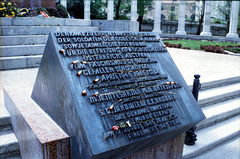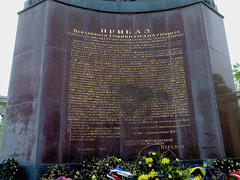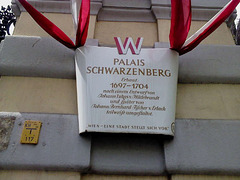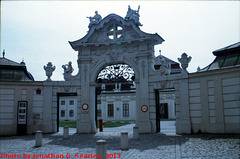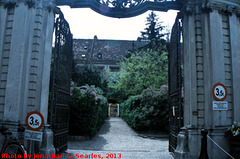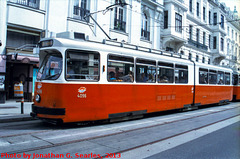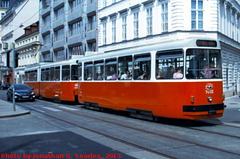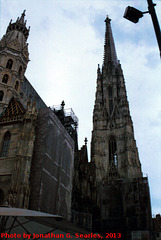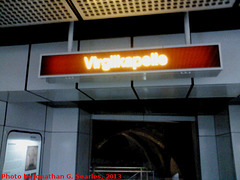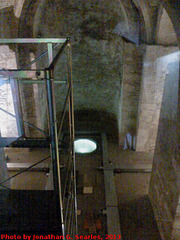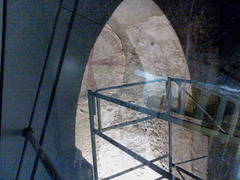
Austria
I've now visited Austria four times, twice in 2005, once in 2007, and once in 2013, the first three times for hiking, and the fourth time to see Vienna. Anyway, here are the Austrian photos! :-)
Wien (Vienna), Picture 5, Edited Version, Austria,…
| |
|
The reason this photo lacks more information is....I don't have any! I think the building is a hotel, but I don't even know that. I decided to post the photo because it is, nevertheless, an attractive building.
(French Embassy) Wien (Vienna), Picture 8, Edited…
| |
|
This is a numbered street shot from my Wien collection, but I should add that this is the French Embassy. This complex is much bigger than it looks in this photo, which is surprising, in fact, when you consider the fact that France isn't the empire it used to be. The dome in the background reminds me a lot of some of the buildings in Prague, especially St. Nicholas Church in Staromestske Namesti (not the one in Malostranske Namesti).
Soviet World War II Memorial, Edited Version, Wien…
| |
|
In the West, the Soviet Union's role in World War II is downplayed. Britain is said to have "stood alone," which is only part true. Britain was alone on the Western Front, but the Soviet Union inflicted the vast majority of Axis casualties in Europe, and took the vast majority of Allied casualties. Some of this ignorance is a result of Cold War propaganda, but to be fair a lot of people don't like to view Stalin as any kind of hero. Interestingly, I didn't find Stalin mentioned on this memorial, and obviously it's the better for it. Austria attempted to remain neutral during the Cold War, so it's understandable why they allowed this memorial in their capital, regardless of the Soviet contribution in the war. Still, I had never heard of it and was surprised to see it.
Soviet World War II Memorial, Picture 4, Edited Ve…
Soviet World War II Memorial, Picture 6, Edited Ve…
| |
|
|
|
This column is the centerpiece of the monument, and has the names of dead Allied soldiers on the base. Presumably, these were only those killed in Austria.
Soviet World War II Memorial, Picture 10, Wien (Vi…
| |
|
This is a list of the Allied casualties killed in Austria during the war. It isn't clear whether it includes only Soviet troops or all allied troops.
Palais Schwartzenberg Plaque, Wien (Vienna), Austr…
| |
|
This is the historical marker for the Schwartzenberg Palace, built by the Schwartenberg family (if I'm not mistaken) between 1697-1704. The Schwartzenbergs are Austrian, but the Czech MP, Karel Schwartzenberg, is one of them. This isn't so surprising given the historical connection of the Hapsburg Monarchy, which ruled Bohemia, to a greater or lesser degree, from 1526 to 1918.
Palais Schwarztenberg, Edited Version, Wien (Vienn…
| |
|
This is the portal to one of the entrances to the palace. The Baroque style is evident, in line with its era.
Palais Schwartzenberg, Picture 2, Edited Version,…
| |
|
This is another entrance to the palace. I liked the path through the garden, although I didn't enter as it's private property (although tours are done, if I'm not mistaken).
Tram #4096, Edited Version, Wien (Vienna), Austria…
| |
|
In addition to dual-power trolleybuses, Wien also has traditional trams, credited with giving Einstein his ideas on the relativity of time at the speed of light, above it, and below it. These trams are of newer heritage, as you can see from the bogies (trams of Einstein's era were almost always four-wheel and non-bogey), but I know little else about them. Additional information would be welcome, although I may follow up with more research as it is.
Tram #1480, Edited Crop, Wien (Vienna), Austria, 2…
| |
|
The rear carriages on some of these trams appear to be unpowered, with the lead unit being articulated, resulting in a total of 10 axles. This system was experimented with in Prague, at least with pairs of T3's (which are non-articulated) pulling unpowered coaches based on them, but ultimately the unpowered trams weren't retained.
(St. Stephen's Cathedral) Wien, Picture 20, Edited…
| |
|
When I originally prepared the photos from this roll, I had forgotten what this was, so I just made the title another generic "Wien" photo. This is St. Stephen's Cathedral, or the Stephensdom, built and rebuilt in various forms between 1263 and 1511, although the two towers date to about 30 years earlier (the exact date isn't clear), as they had been from the second church on this site, as the Stephensdom is the third (or possibly fourth). The first known church, built between 1137 and 1160. One theory that some historians and archeologists have, though, is that there was an earlier church (or possibly pagan temple) as far back as the 4th Century, as in 2000 a cemetary carbon-dated to that period was found during an archeological dig. Normally, of course, cemetaries in Christian countries were adjacent to churches. However, the 4th Century was not well recorded enough to know for sure, as it was at the beginning of the "dark ages" of European history. The during later periods, there were catacombs, which were used until 1783, and these still exist. An estimated 11,000 bodies are kept there. Another cemetary (not the 4th Century one) also existed next to the cathedral until 1781, with its own separate chapel (more on this in a later post). There are also crypts that are still in use, but these are used for church officials, for example the Bishop's Crypt, which was used as recently as 2004 to inter Cardinal Franz Konig. On the more positive side, the Stephensdom first had an organ in 1334, which must have been a very impressive piece of technology at the time. In 1945, the Cathedral was burned, although not directly from battle (although the Nazi commandant of the city had unsuccessfully ordered the cathedral destroyed). Although the city was invaded and occupied by the Soviet army in the last two months of World War II, looters set fire to nearby shops, which spread to the cathedral. Fire and bombing had been anticipated, so protective shells made of bricks had been constructed around parts of the interior. However, these were not enough to save everything, and this included the organ that existed at the time (it isn't clear if it was the 1334 original). An electric organ was fitted in 1960, roughly eight years after the cathedral reopened, and this was replaced by a more traditional mechanical one in 1991.
(St. Stephen's Cathedral) Wien, Picture 21, Edited…
| |
|
Here's a shot of the later, gothic spire, also called the Steffle. It was added over 65 years between 1368 and 1433. It doesn't look it (maybe because it's also thicker than many steeples), but it is actually 136 metres, or 449 feet, tall. That makes it the 13th tallest church tower in the world, which is especially impressive when you consider how old it is, and might explain why it took 65 years to build. At the time of construction (and I haven't researched this thoroughly so correct me if I'm wrong) it would have been the second tallest in the world, and the one tower which was taller, on Lincoln Cathedral, collapsed in a storm in 1549, suggesting that the engineering was not as good (after all, England never has had the same level of storms as many other countries). Architecturally (in the artistic sense), however, Lincoln is well-regarded, and survives, albeit without its original 3 spires.
Rochusgasse U-Bahn Station, Wien (Vienna), Austria…
| |
|
As with the Prague Metro, a number of archeological finds occurred as a result of the Vienna U-Bahn's construction. These columns, which look Roman, but are probably medieval or even Rennaissance. There isn't any historical marker for them that I noticed, but some historical detection work could be done to determine what buildings were in the area during likely time periods. This U-Bahn station, serving Line U3 only, is relatively new compared to some of the others, having opened in 1991.
Stephansplatz U-Bahn Station, Wien (Vienna), Austr…
| |
|
|
|
Stephansplatz U-Bahn Station, in contrast to Rochusgasse, is one of the older stations, having been completed in 1978, although contruction had taken five years. The station was one of the earliest to have been planned, with the original proposals dating to the 1880's. One nearby building, the Palais Equitable, was even given a covered staircase in 1887 that was intended for eventual use as part of the U-Bahn. The square that the station named for is where St. Stephan's Cathedral is, and you can find an interesting photo of the construction here:
en.wikipedia.org/wiki/File:016L08--0675_Stadt,_Stefansdom,_im_Vordergrund_Baugrube_U-Bahn,_Nachtaufnahme.jpg
Of course, at this point, 1978 is long ago enough so that the station looks retro, in its own 1970's way. This is one of the elevators, which captures the period feel even if it has nothing to do with trains. This station encountered a number of unusual circumstances during its construction. One of these circumstances was the sandy ground in the neighborhood. Given how long the area has been urbanized, with concrete, cobbles, foundations, catacombs, and mortar going down quite far, it's surprising to me that this was still an issue in the 1970's, but then I'm not an engineer. For that matter, its surprising that St. Stephen's Cathedral and its associated catacombs, tunnels, and underground chambers could be built at all, particularly in the pre-industrial era. Groundwater was another problem. This is usually a problem when tunnels are involved, and gave rise to the original steam engines in the 17th Century, as they were required pumping water out of coal mines, but in Stephansplatz the groundwater is somewhat unpredictable as well. To deal with the sandy soil during the construction of the station, engineers attempted to mix a binding agent into it, but this now has the side effect of reacting with the groundwater, producing butyric acid, which can be harmful to humans, but which mostly produces a bad smell in the station (I haven't read of any injuries or deaths). There are a few very brief explanations about that here in English:
homepage.univie.ac.at/horst.prillinger/metro/english/faq.html
www.vienna.net/vienna-guide/metro.html
Surprisingly, I couldn't find a technical paper on it.
Supposedly the catacombs also smell quite bad, but that could just as easily be that they're catacombs:
www.cosmotourist.com/travel/d/i/2561403/t/vienna/catacombs-in-st-stephans
However, another underground feature of this neighborhood discovered during the construction was the Virgilkapelle, built in about 1307, but abandoned in 1781 and left forgotten until 1972.
Virgilikapelle, Wien (Vienna), Austria, 2013
| |
|
As mentioned earlier, construction crews discovered the Virgilikapelle while builting the Stephansplatz U-Bahn station in the 1970's. The Virgilikapelle was a medieval chapel that was constructed in about 1240, and ended up under another chapel called the St. Mary Magdalene Chapel, built in about 1307, which served a cemetary (not the old 4th Century one, but a later one that was closed in 1732). The accounts I've read seem to be a bit illogical in this way, as it has been presumed by some historians that the two were built simultaneously. The historical plaque (quoted below) does put the date of the chamber's construction at 1240. In 1781, the St. Mary Magdalene chapel burned down, and it was at that point that the history becomes less clear. Essentially, historians had presumed that the Virgilikapelle had been demolished with the other chapel, so its discovery, more-or-less preserved, under Stephensplatz came as quite a surprise. For that matter, few were sure (and presumably some may still be unsure) that it was even called the Virgilikapelle. Rather than destroying it after documenting it, as has often happened to archeological finds elsewhere, the Virgilkapelle was preserved as-is in close to original condition, although some of the paint faded. Soon after its excavation, it was damaged by that notorious Stephensplatz groundwater as well. However, it remains in remarkably good condition for an underground chamber built in the 13th Century, used for almost 500 years, and then buried for 190 years. In addition to preserving it, the U-Bahn Station was built to accomodate it, with windows to peer into it, and those 1970's signs again. There is also a multi-lingual, and quite detailed, historical plaque. It reads:
"Construction work on the U-Bahn (subway/underground) in 1972 led to the discovery of the foundation walls of the Chapel of St. Mary Magdalene, wich was demolished in 1781, and the Chapel of St. Vergilius that lay beneath it. This subterranean space, which, with a surface area of ca. 100sq.m. and a height of 8m, was relatively large by medieval standards, had an unusual groundplan with six apses. Along with its position next to St. Stephen's, this implies that it was part of an important princely building project.
The architecture and mural paintings were completed around 1240, thus dating from the reigns of the last Babenberg dukes: Leopold VI and Friedrich II were already trying, at that time, to secure the foundation of a bishopric in Vienna. As ordered by the pope, leading abbots had to visit the place where the relics of the episcopal patron, St. Coloman, were kept. It is therefore interesting that the space is orientated so that sunlight aligns with the central axis of the chapel on 13 October, the feast day of the saint.
The death of Friedrich II in 1246 meant the end of the ambitious plans. The vaulted space was used, from ca. 1300, as an ossuary, a place of burial, and private chapel. There were alters dedicated to Sts. Erasmus, Helena, and Vergilius, from the latter of whome the building takes its present-day name."
Virgilikapelle, Picture 2, Wien (Vienna), Austria,…
| |
|
Here's a view into the chapel. It's not open to the public, as it's fragile, and you can see the monitoring equipment, including what looks like seismic equipment set up to watch over it. You can see the water damage at the far end of the apse (if that's what it is).
Virgilikapelle, Picture 3, Wien (Vienna), Austria,…
| |
|
|
|
Because the Virgilikapelle was underground, there were never any stained glass windows. However, indentations were built into the walls, with gothic arches, as if there were windows.
Jump to top
RSS feed- Latest items - Subscribe to the latest items added to this album
- ipernity © 2007-2024
- Help & Contact
|
Club news
|
About ipernity
|
History |
ipernity Club & Prices |
Guide of good conduct
Donate | Group guidelines | Privacy policy | Terms of use | Statutes | In memoria -
Facebook
Twitter




